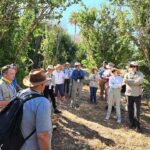
Dreams really can come true, and recently one of mine did. Since taking part in the Pompeii Food and Drink Project, I have longed to join a hands-on dig.
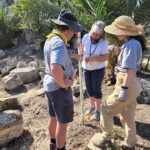
Twelve years later, working with many of those same people, I joined the Melite Civitas Romana Project, examining the ruins of a Roman Domus and its context within the city of Melite on the island of Malta. Dave and I had been to Malta before, even visiting the museum at the site. Who knew I would return? Working again with old friends and excavating Roman history was a double blessing. Oh, and I made a lot of new friends too.
While Malta has been occupied since Neolithic times, it reached its heyday during the Roman period from 218 BCE through 535 CE, when it was incorporated into the Byzantine empire by Sicily. The remains of approximately thirty villas have been found scattered about the island. The primary city of Melite had long been thought to be buried entirely beneath the towns of Mdina and Rabat.
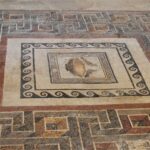
Imagine yourself as a gardener tasked with planting trees. You stab your shovel into the ground. And clunk. You hit something. This is what happened to workers planting trees in a garden just outside the city of Mdina in 1881. The workers uncovered mosaics and Islamic burials. Antonio Caruana, curator of the archaeological collection at the Bibliotheca, was entrusted with the excavation. Initially believing it to be a Roman villa, they had actually uncovered a richly appointed Domus or townhouse within the boundaries of the Roman town of Melite. Laid out in the typical peristyle floor plan, the Domus is believed to have been built in the 1st century BCE and remained in use into the 2nd century CE. Until its discovery, most thought the town lay completely buried under the medieval city.
They erected a museum over the rooms they discovered to preserve the mosaics and store the artifacts. Unfortunately, in 1899, despite knowing of the existence of the Domus and the associated buildings surrounding it, a road was cut to the train station, destroying a good portion of the house, the Roman road, and the surrounding structures.
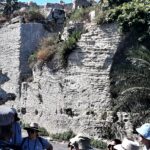
From 1920 to 1925, Sir Themistocles Zammit investigated the site. His work extended in all directions and uncovered Islamic burials with the remains of smaller structures beneath them. Modern investigative practices were unknown then, and though he added somewhat to the collection, what remains are grainy photos of the walls he located. But what were they?
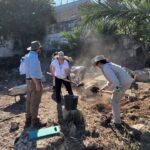
That was where we entered the picture one hundred years later. To prepare for the dig, ground-penetrating radar was performed on the site in 2019, where evidence of walls and voids (rooms, cisterns, etc.) were found. The plan to begin in 2020 was postponed because of Covid. Finally, on 13 June 2022, our team started work on the site.
Four areas were identified, including the garden area in front of the museum and the road behind it. Also included was the section across the 1899 road where Zammit discovered additional walls. While part of the effort is to understand the Domus itself, it is just as important to place it in context with the town to which it was attached. Walking down the modern road, you can see where the ancient road that ran behind the Domus continues. Along the way curving behind the house were many smaller, less decorated buildings. Were these shops? Homes of working people? And what were the walls on the other side of the 1899 road? You can easily see walls, even a cistern, sliced by the modern road.

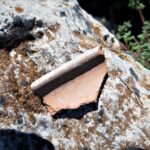
I was assigned to the team in area 4, across that road. A grainy 1920s photo shows a series of walls. Our task was part of the long-term project to locate them again so we could begin to understand what they were. As we dug through Zammit’s spoils, the stratification layers were no longer in situ. This was exciting, as pottery shards were everywhere once we removed the vegetation and topsoil. It didn’t take long to find fragments of rims and bases of an assortment of vessels, such as pots, jugs, and amphorae. Roman glass fragments were mixed with modern glass, as the pieces were no longer in their original position. Ancient pots sat beside medieval pottery. Prehistoric finds lie next to WWII coins. Imagine my excitement finding three coins, only to discover when cleaned that they were dated 1942. Well, that is history, too, and they were bagged separately. Most of the pottery was standard terracotta. However, bits of glossy red Samian Ware were found.
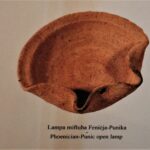
Some of the more exciting items I found, besides the coins, were rims of pots and several larger fragments I found that were buried together. I hope most of the pieces were there to put it back together. I found several large amphorae handles and two crimped edge pieces of a Punic oil lantern.
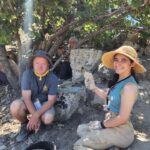
To avoid the island’s heat in June, afternoons were spent washing the finds each day in the coolness of the catacombs down the road. We spent our evenings exploring other sites or eating gelato and watching the sunset.
I can’t wait to return next year.
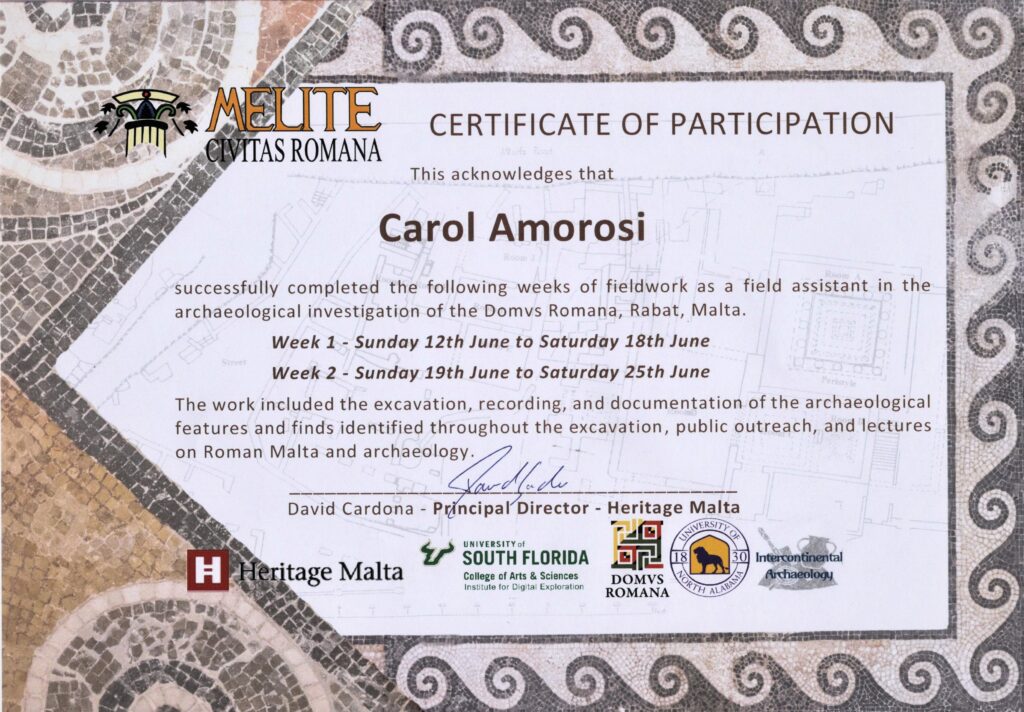
Looks like an amazing time!
Jessica, it was. And something I’ve wanted to do for a very long time.